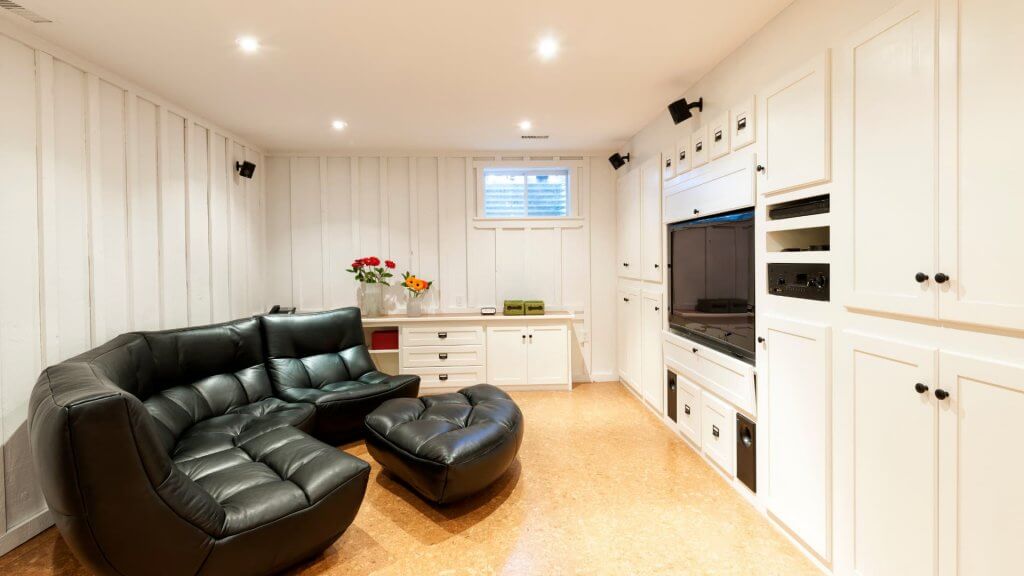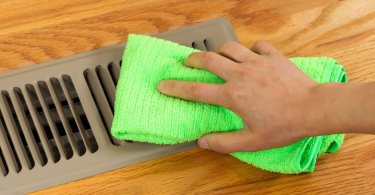In a modern-day home, a basement is rarely used as a storage space. Currently, many dwellings have basements that are designed as living spaces. However, most homes have cold basements, and as winter sets in, these drafty and cold basements become inhabitable. You might ask yourself: how to heat a cold basement efficiently?
If you are thinking of utilizing your basement as an extra room, a kids’ play area, theater, or a gym, it’s time to invest in some easy and affordable heating options. Here is how you successfully and efficiently heat a cold basement!
Why Are Basements Cold?
All basements, no matter where you live, are colder than the other floors in your home; ever wondered why that is? Well, there are several reasons why.

1. Ground Chill
Most basements trap the cool air and recirculate as undergrounds are much colder than above the ground floors.
2. Moisture
Another reason for the cold basement is trapped moisture. The excess moisture can make the air damp permanently, making your basement feel chilly all the time. Did you know that in America more than 60% home basements suffer from moisture (source)?
3. Heat Rises
Science tells us that warm air is lighter than cold air and therefore, the heat rises. That means that the heat from the basement travels to the above floors while the cold air travels downwards towards the basement. This phenomenon makes your basement chilly.
Why Basement Heating Is Important
There is a reason why people extend their ducting system to warm up their basement. A cold basement affects the overall temperature of the house, hence affecting the heating bills as well.
A warm and habitable basement can turn into a perfect additional living space. You can convert this space into your studio, a gym, or even a playroom for the kids.

Here are some of the best methods you can use to warm up your basement and keep your home warm and toasty during brutal winters.
1. Infrared Space Heater
An Infrared heater is the most popular method to heat up a basement. Anything that is in direct contact with the infrared space heater will get warm, while anything that is in the shade or away from it will remain cool. This type of heater is great for warming up all parts of your home as well as its inhabitants.
This type of heater is great because it doesn’t affect the quality of the air or dry it out. Infrared space heaters come in various sizes, with wheels and also various options. So, you can get any model according to your budget, the size of your basement, and your design preference. With no installation required and little or no maintenance, this type of heater is the most popular choice when it comes to efficient methods for basement heating.
Related article: 6 Types Of Space Heaters
Benefits:
- Direct and Instant heat
- Air quality remains the same
- Quiet and discreet, ideal for spaces used as sleeping areas
- Rotatable wheels
Drawbacks:
- It can become a fire hazard
- It doesn’t converse heat
- Direct heating can cause skin damage
2. Oil-Filled Radiator
Oil-filled radiators are silent workers; you won’t hear a peep out of your radiator even if it runs all day. Simple and smart, these radiators are pretty efficient to warm up any space. They are easily moveable so you can shift them to any room. Oil-filled radiators come with 3 heat settings: low, high, and ECO, along with five temperature options, giving you constant warmth and a comfortable atmosphere.
Related article: 6 Types Of Space Heaters
These heaters use convection heating to steadily warm up the room and keep it warm without compromising the air quality or making the air dry. You can choose the size and price range according to the size of your basement. No installation required; just plug in and enjoy your toasty winters.
Benefits:
- Silent, no humming apart from a faint click of the thermostat adjusting
- Heats a large surface area
- Easy to clean and maintain
- Easy to plug in, requires no installation, and is also portable
- Efficient heating
- It doesn’t make the air quality arid
Drawbacks:
- Gets super-hot when turned on, not safe for children or pets
3. Ceramic Space Heater
Ceramic space heaters are yet another suitable method to warm up any space, especially the basement. As these come in many shapes, sizes as well as price ranges, they are ideal for all kinds of homes and also very affordable.
Both wall-mounted and floor ceramic space heaters are available with an easy installation manual. For harsh winters, you can also get fan-assisted ceramic space heaters that will warm up any room faster than the normal ones. All you need to do is plug them in and enjoy the warmth encircling you.
Almost all ceramic space heater models are portable and lightweight; this makes them ideal if you are always moving homes or if you are a renter.
Benefits:
- Unlike oil-filled radiators, ceramic space heaters are cool to touch, ideal for homes with kids and pets
- Portable and lightweight
- Heats up almost instantly
Drawbacks:
- All models are designed for small areas
- It takes a while to heat up space
4. Underfloor Heaters
If you are remodeling your home or buying a new one, underfloor heaters are an ideal choice. These heaters use electric resistance cables, concealed in thin mats, to emit heat. These mats are then installed underneath the flooring to ensure even heating throughout the basement. Underfloor heaters are suitable for all kinds of flooring, for example, tiles, stone floors, engineered wood, as well as laminate floors.
You can control the temperature through your thermostat controller as these cables are connected to the main thermostat of your home. With underfloor heaters, you can ensure uniform heating as well as a reduced heating bill.
Benefits:
- Highly efficient
- Effortless control
- Completely safe for kids and pets
Drawbacks:
- Expensive
- The installation takes time
8 Cheap Ways To Heat A Cold Basement Efficiently
Apart from using heating gadgets, you can also check out the following efficient and low-cost tips to warm up your basement. While heaters and other gadgets work, they won’t be efficient if there are underlying problems. Cold drafts seeping in, windows with gaps, and cold flooring will always kill the heat quicker, keeping your basement ultimately cold.
1. Drafty Windows And Gaps
It’s safe to say that in most dwelling spaces, the basement is the one we least bother with. Because it usually is not a living space, most basements are not properly done as the rest of the house. There might be gaps and old windows letting in cold air.
These drafty windows and cracks should be properly sealed as they keep the room from getting warm, even with proper insulation. Sealing windows is easy and not as costly as most heating gadgets; you can use either caulk or a DIY window insulator kit to seal drafty windows and stop cold air from penetrating your basement.
Another simple yet effective gadget is a ‘draft stopper’. Use draft stoppers on doors and windows to seal gaps that may let in the cold air from outside. These small cracks may just be the biggest reason why your basement feels chilly all the time, especially during cold winters.
The plumbing system also runs through the basement to the rest of the house; sealing the corners of these pipes and walls with foam will also help with heat escaping.
2. Properly Insulate First-Story Walls
Now, according to science, the hot air rises up, and the cold air settles down. By this logic, if your first floor is not adequately insulated, it will act as an outlet to descend the cold air into the basement. Identifying where the draft is coming from will help you solve the problem sooner than later.
3. Vent Flaps
Most furnished homes come with basements that are equipped with vent flaps. However, cheap vent flaps are inadequate in preventing cold air from coming in. With such vent flaps, it will be hard to warm up the basement no matter what you do. Investing in better vents like ‘floating shuttle’ will help you keep your basement warm and also help you reduce your energy costs.
4. Properly Insulating Basement Ducts
Ducts are the primary culprits for getting the cold air in: through a small opening, the cold air shoots in with a lot of pressure. If you have bathroom ducts or dryer ducts in your basement, your basement will feel like Siberia as such ducts are no less than pipes of thin aluminum or paper-thin plastic. These provide no insulation. In fact, they make the place even colder. The most cost-effective way is to wrap such ducts with insulation.
5. Use Thermal Camera to Locate Cold Spots
You can either buy a thermal camera or lease one from a rental center and use the technology to locate cold spots in your basement. This can be done to both furnished and unfurnished basements. With an excellent powerful thermal camera, all you need to do is stand in the middle of the room and point the camera in various spots to learn where the energy losses are occurring the most. With cold spots detected, you can fix those areas to conserve energy and warm up your basement.
6. Install Carpets and Rugs
Making a place cozy doesn’t mean you have to spend a lot of money: with simple tips and tricks, you can make a huge difference. Did you know that 13% energy loss occurs through floors? And if you insulate the flooring, you are most likely to conserve heat. Most basements have stone or concrete flooring, and no matter what you do, such flooring will always be cold to touch.
Wall-to-wall carpeting is a great idea to minimize heat loss. With the help of rugs or thick shag, you can increase the distance between floor and feet hence keeping the cold away from your body.
Pro tip: thick woolen carpets work better than any other kind.
7. Replace Windows
Just like the flooring, a lot of heat is lost because of single-glazed windows. Around 48% of the basement heat is lost due to window glass. Replacing your windows or blocking them with 99% tint might solve more than half of your problems.
However, having 99% tinted windows can make your basement look gloomy and claustrophobic. Switch to double-glazing or triple-glazing glass for your windows. Such windows are most effective for insulation and preventing heat loss while also letting sunshine into your basement.
Apart from that, one-way reflection windows are also great and cost-effective as they keep out 91% of solar rays but still allow maximum light penetration.
8. Curtains And Cellular Shades
A cozy basement is all you need to spend your winters in comfort, however, heating the basement can be very costly. Therefore, we advise investing in heavy shades. Install heavy curtains or cellular shades to add layers.
You can open up the curtains in the daytime, let the sun fill the room and make it warm. And by dusk, close the curtains and enjoy the conserved heat while sipping a large mug of hot chocolate. You can eliminate 80% of heat transfer through heavy curtains and cellular shades to save energy.
Related article: Propane vs Kerosene Garage Heater: Which is Better?
Conclusion
Your basement doesn’t need to be a cold or uninviting space in your home. It’s too much of a good space to go to waste due to temperature issues. With the above-mentioned easy and cost-effective ways to heat a cold basement efficiently, you can create a cozy haven right at the base of your home.
Spend your winters with your family in a toasty atmosphere without worrying about the utility bills!
Related articles:








Leave a Comment